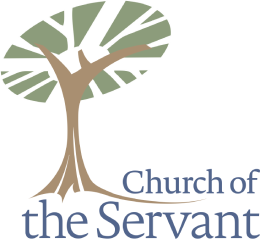The weekly celebration of communion at COS is one of the hallmarks of our worship together. This practice and the details of how we celebrate communion together were given much thought in the formative years of COS, and has been deeply meaningful to members and visitors for 50+ years.
The way we come forward, form circles, and pass the bread and wine to each other all reveal deeply-held values about the Lord’s Supper. Processing to the front of the sanctuary reveals the value we place on actively pledging our fidelity to Christ in communion (as opposed to passively remaining in our seats to receive the elements.) Forming circles reveals the value we place on our unity in Christ. Passing the bread and wine to each other reveals the value we place on serving each other. Taken together, these practices imitate the way people come together around a table to share a meal, thus helping us remember the Last Supper Christ celebrated with his disciples, and helping us look forward to the Great Feast we will one day celebrate in the new heavens and the new earth with all the saints.
Giving up these practices would diminish our experience of communion. But there are other details that are more easily given up. For example, we have made the change to using exclusively grape juice as opposed to both grape juice and wine. While the use of wine was important and meaningful to some, wine was problematic for others, and the use of both at various circles was confusing.
Another example is the change we have made from passing a loaf of bread and breaking off a piece to having the bread pre-cut and passed around in baskets. Passing the loaf was also meaningful, but was let go over concerns for health and hygiene.
Where the bread and wine come from has also changed over time. In past years, individuals and families took turns bringing the bread and wine from home. This was scheduled on the “duty roster” along with coffee and nursery, an expectation that everyone in the congregation would serve the church in these ways. This, too, was very meaningful. The bread and wine were brought from the home of congregation members (sometimes homemade, sometimes store-bought) as an offering brought to the Table along with the monetary offerings of the rest of the congregation. This resembled the historic practices of the church where members brought offerings of food to be distributed to the needy. Out of those offerings, the bread and wine were taken for use in celebrating communion together. As the logistics of this practice grew increasingly difficult (i.e. making sure the people remembered, were able to buy the ‘right’ bread and wine not containing allergens, knew how to prepare the elements for the service, etc.), we transitioned to having church provide the elements every week, though it is still brought forward at the time of the offering by a variety of members.
This summer we plan to make another change: starting Sunday, July 7, we will begin using all Gluten-free bread. For years now we have had a small basket of gluten-free bread offered within the circle as an alternative to gluten-full bread. But this practice separates out those who are taking gluten-free bread from everyone else in the circle passing the elements to each other. Also, the separate gluten-free bread is not enough to allow those with severe allergies to participate. Simply having gluten-full bread in the circle presents too great a possibility of contamination and allergic reaction. Moving to all gluten-free elements will allow these people to come forward and partake of one loaf with the rest of the body.
This coming ministry year, our theme as a congregation will be Fellowship – the second gift in our vision statement. As we share the gift of fellowship (“koinonia”) as a community, we are looking not to our own interests, but to the interests of others. (Phil. 2:4) In this small but significant way, we embrace the oneness we share in Christ and give honor to one another. (1 Cor. 10:17; 12:26)
While we are glad that this change will allow more people to participate in communion, we also recognize that this is not a magic solution for including everyone around the Table. We acknowledge that there are other sorts of dietary restrictions that may prevent people from eating the gluten-free bread. However, we hope this is one step on the journey toward the ultimate feast where every nation and tribe and language and people (with dietary restrictions) will sit around the Table together at the marriage supper of the Lamb and his Bride.
For those with allergy concerns, a list of ingredients will be on the back page of the liturgy along with the song credits every week.
Ingredients: water, egg whites, potato starch, brown rice flour, white rice flour, sorghum flour, tapioca starch, cane sugar, millet flour, canola oil, yeast, salt, psyllium husk, xanthum gum, and distilled vinegar

